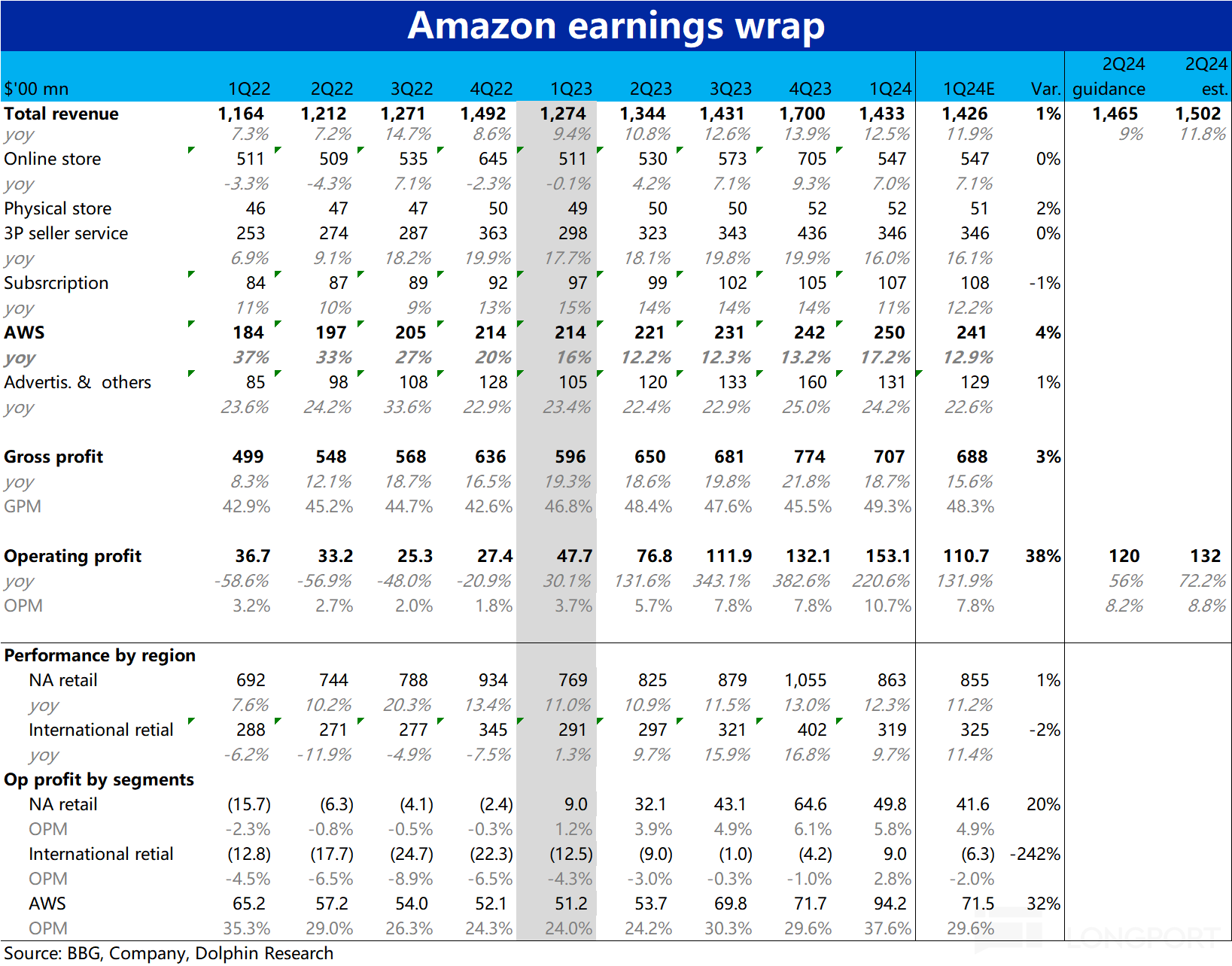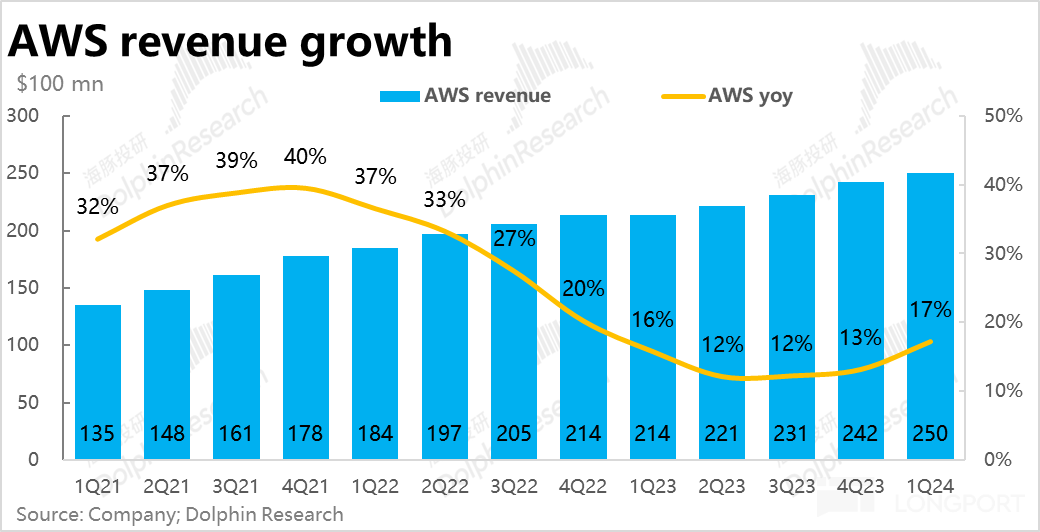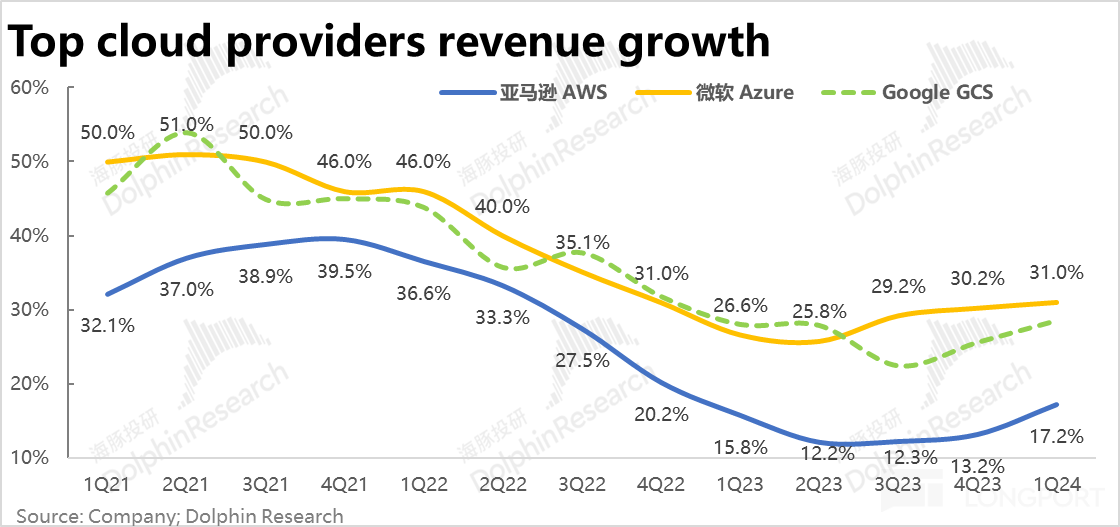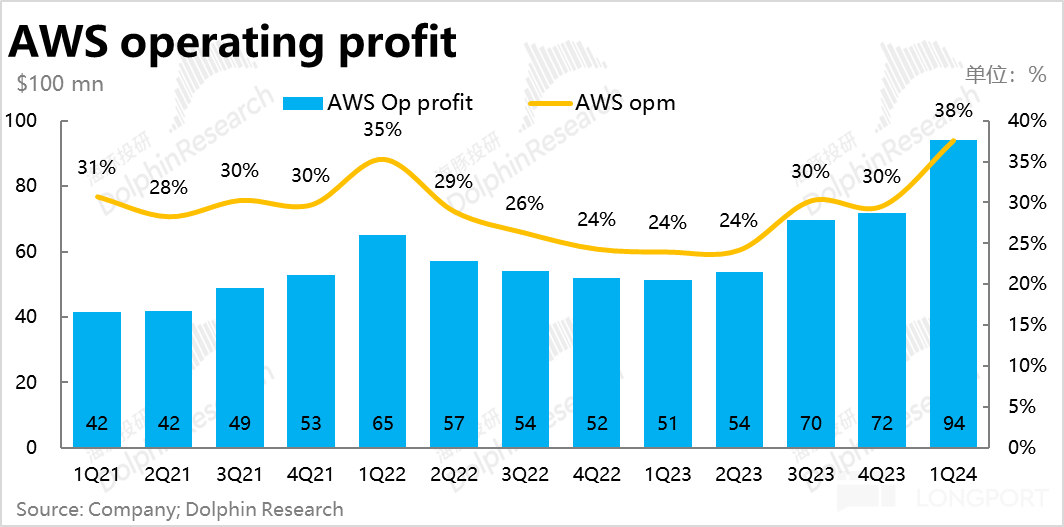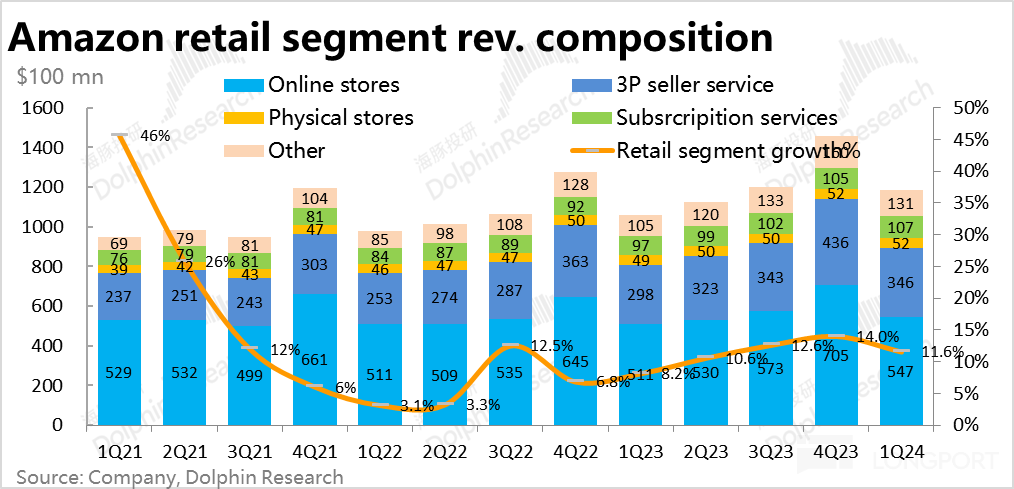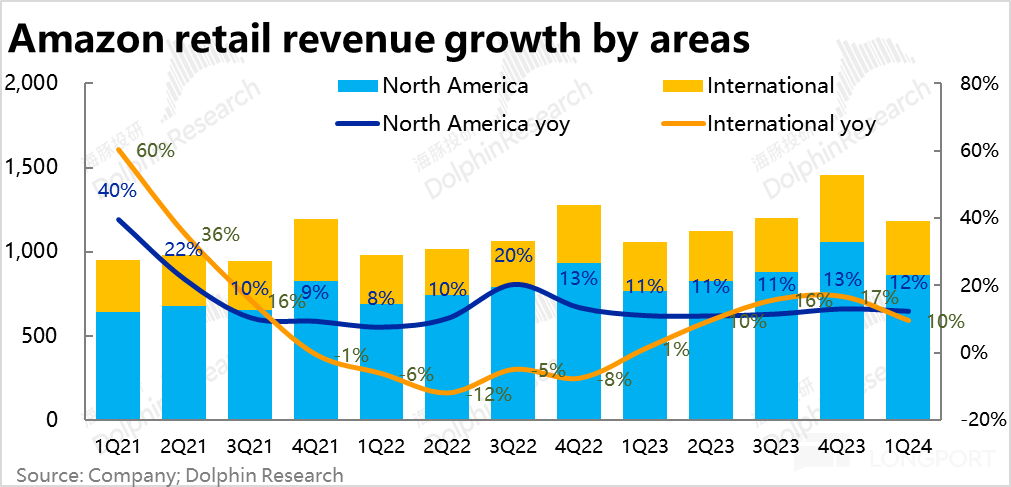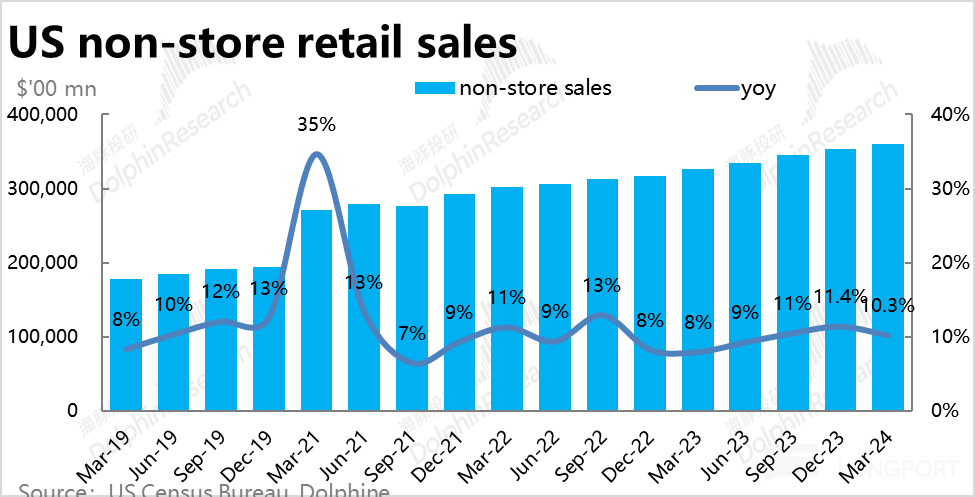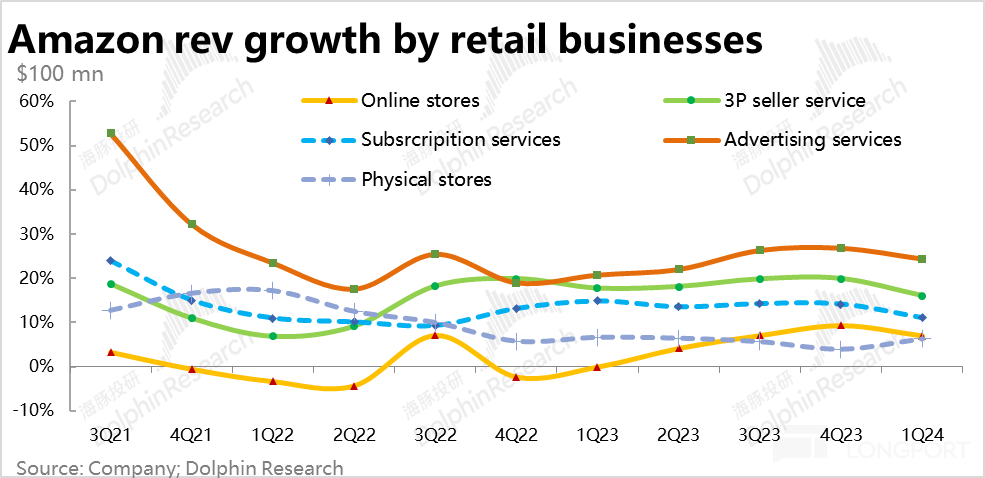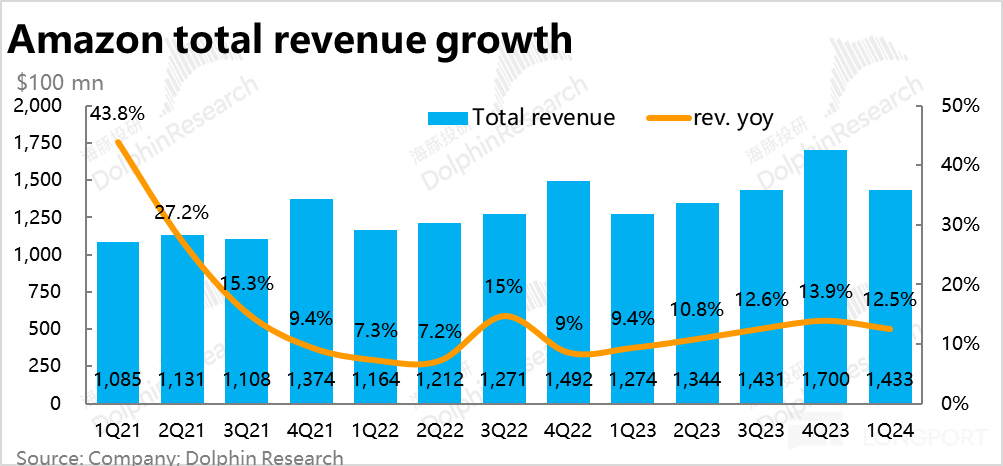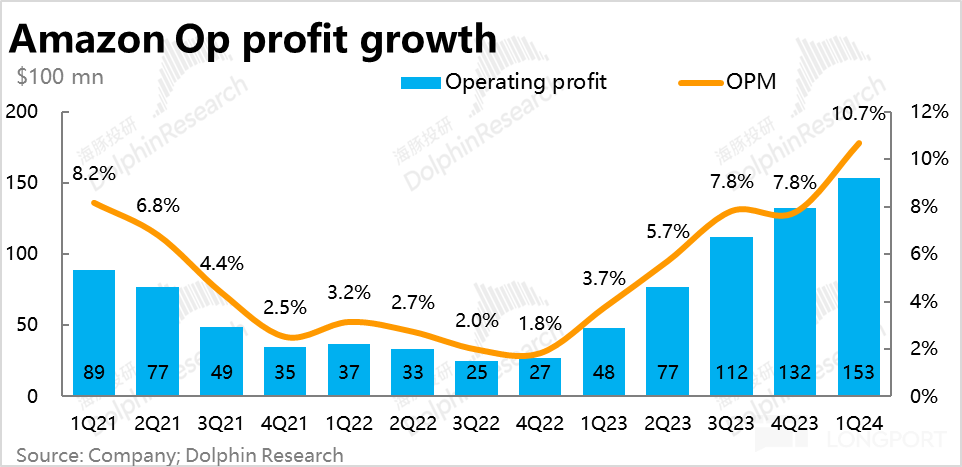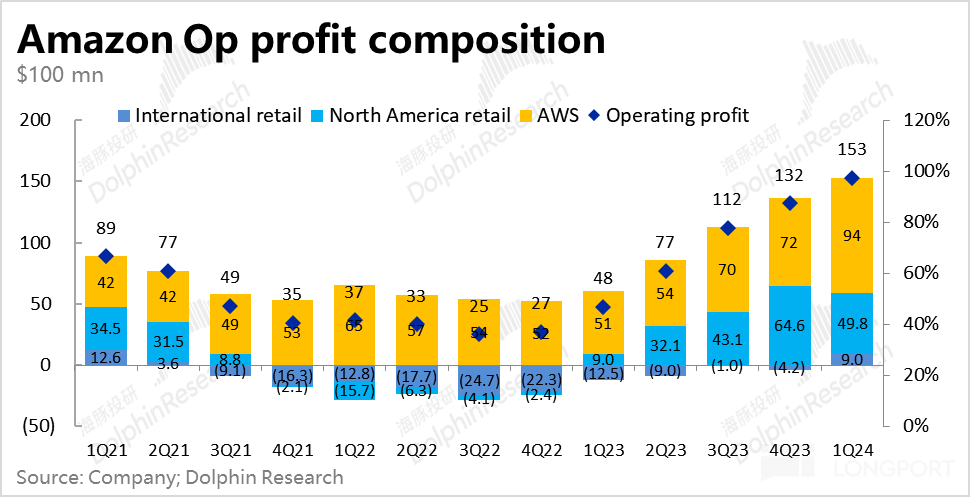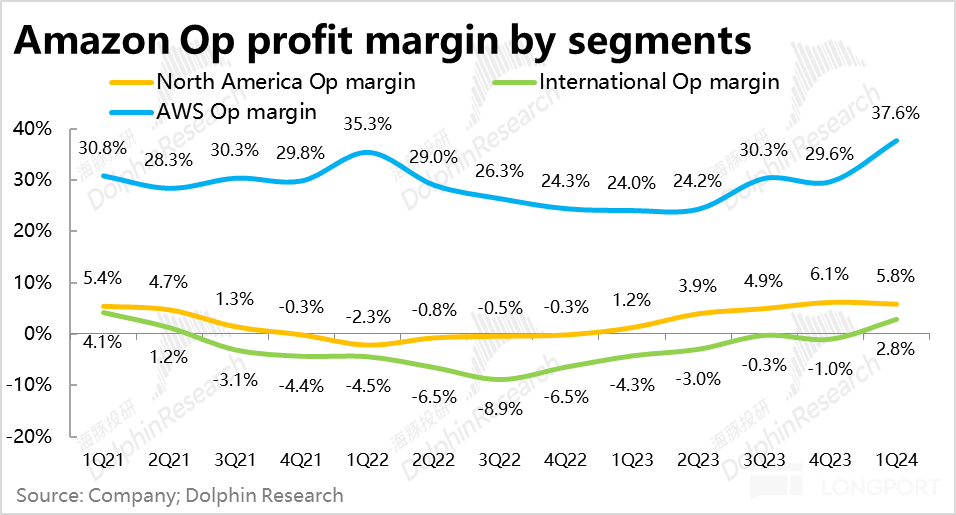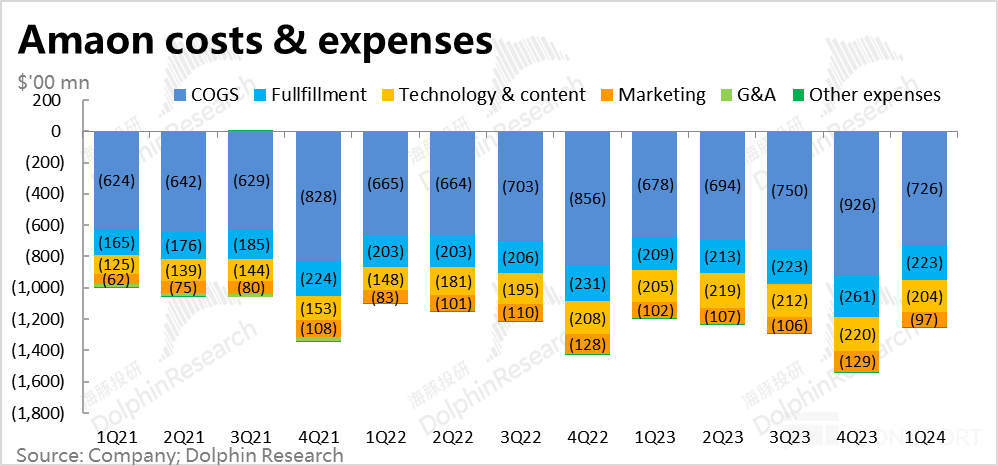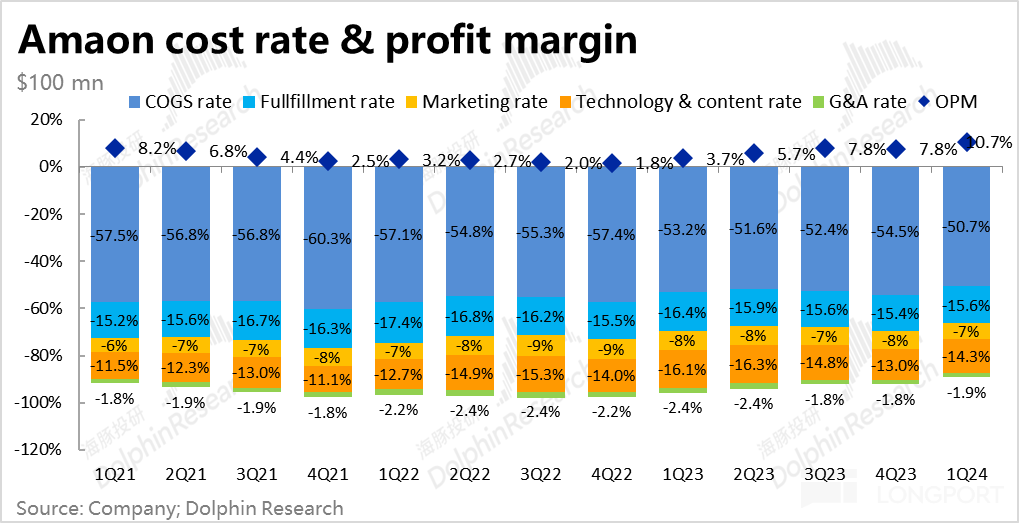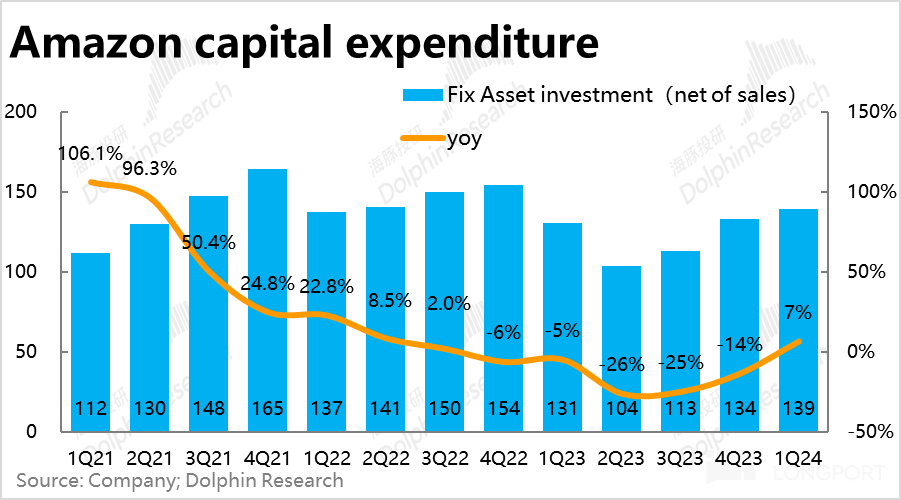
 Likes Received
Likes Received Posts
PostsAmazon: Rocketing Profits, Collision of Strong Performance and High Expectations

After the U.S. stock market closed on April 30th, Amazon released its financial report for the first quarter of 2024. Overall, the revenue growth was steady, largely in line with expectations, with the highlight being the stronger-than-expected acceleration in cloud business (consistent with peers); on the profit side, there was another astonishingly large beat (+38%), mainly attributed to the cloud business. The key points are as follows:
1. Another steady revenue performance and significant profit beat, but what's different this time? In terms of overall performance, Amazon achieved a total revenue of approximately $143.3 billion this quarter, slightly higher than the market's expectation of $142.6 billion. The year-on-year growth rate was 11.9%, a slight slowdown of 0.6% compared to the previous quarter. Specifically, the revenue beat was mainly attributed to the significant acceleration of the AWS business, while the slight decrease in year-on-year growth was mainly due to the reversal of the favorable impact of the depreciation of the U.S. dollar and the steady slowdown in retail business growth.
The overall operating profit reached $15.3 billion, far exceeding the sell-side expectation of $11.1 billion. Even though the buy-side generally expected higher figures in the range of $12-13 billion (Dolphin Research expected $12.9 billion), the actual performance still significantly beat expectations. Breaking it down, this was mainly due to a substantial increase in the profit margin of the AWS business, which increased by 8% compared to the previous quarter.
2. AWS revenue and profit performance were strong across the board, the biggest highlight of the quarter: AWS revenue reached $25 billion this quarter, with a year-on-year growth rate rising to 17%. Although the market had already expected the growth rate to increase to around 15% prior to the results, the actual performance was even stronger . However, considering the equally better-than-expected performance of Azure and GCS, it was beyond expectations, but reasonable.
In a horizontal comparison of the three major cloud service providers in the U.S., the growth acceleration of GCS and AWS this quarter was faster than Microsoft, narrowing the gap in growth rate (Amazon's acceleration by 4%, Microsoft by 0.8%). It can be inferred that Amazon and Google are catching up with Microsoft in AI capabilities/services.
From a profit perspective, AWS's performance was even more remarkable, achieving an operating profit of $9.4 billion, far exceeding the expected $7.2 billion. The operating profit margin surged from nearly 30% to 37.6%. However, such a huge increase in profit margin seems not entirely explainable by the recovery in growth and the promotion of AI capabilities. The last time such a significant single-quarter profit margin increase (+5%) was during the early part of 22 when there was a change in depreciation schedules, so it cannot be ruled out that there may be accounting adjustments this quarter as well.
3. Retail business steady, no surprises or worries: Compared to the strong performance of AWS, the growth of the retail segment was largely within expectations. The retail segment achieved revenue of $118.3 billion, with a year-on-year growth of 11.6%, slightly slowing down by 2.4% compared to the previous quarter. Looking at different segments, the growth rates in North America and international regions both showed similar degrees of slight deceleration, without any surprises. In terms of specific businesses, apart from a turning point in growth for offline physical stores, other sub-segments also generally experienced a slight slowdown in growth. Among them, the widely anticipated advertising revenue growth of 24.3% also decreased by 2.5%, indicating that the positive impact of Prime Video advertising has yet to fully materialize 4. Surprises are not significant under the high expectations of North American retail, while international business exceeds expectations and turns losses around: This quarter, the operating profit of the North American retail sector was 4.98 billion, although the profit margin continued to increase significantly by 4.6 percentage points year-on-year, which was higher than the sell-side expectations but lower than Dolphin Research's expectations. We believe that compared to the buy-side expectations, it may not be significantly ahead. With the current valuation and the vision of a double-digit profit margin for the North American retail business, a profit margin of 5.8% this quarter is not considered significantly exceeding expectations.
However, this quarter, the international retail sector directly turned losses into profits with an operating profit of 900 million, making it the second contributor to profits exceeding expectations after AWS. Although Dolphin Research also expected the international business to turn profitable this year, achieving a profit margin of 2.8% in the first quarter was stronger than our expectations.
5. Not aggressively increasing AI investment, expenses are still on a shrinking track: This quarter, the gross profit margin was 49.3%, 1 percentage point higher than the sell-side expectations, and an increase of about 2.5 percentage points year-on-year. This is still attributed to the rise in high-margin business income such as advertising, as well as further price increases and efficiency improvements in logistics fulfillment. In terms of expenses, due to the implementation of zone distribution in North America and pushing merchants to bear more fulfillment processes themselves, the fulfillment cost rate continued to decrease by nearly 0.8 percentage points year-on-year this quarter, and it is expected to continue to decline in the future.
Research and development, sales, and internal management expenses combined decreased by 3.5 percentage points year-on-year, indicating a trend of expense optimization and efficiency improvement. With the recent AI wave, the capital expenditures of other major companies have generally increased significantly, but Amazon's investment this quarter was 13.9 billion, a net increase of only 5 billion compared to the previous quarter, representing a 7% year-on-year increase. Although it has returned to positive growth, compared to its peers, Amazon's current investment intensity remains more restrained, demonstrating excellent cost control.
6. Profit guidance continues to be strong, but revenue slightly falls short: For the current quarter's performance guidance, the company expects a revenue range of between 1440 billion to 1490 billion, even the upper limit is lower than the sell-side expectation of 1502 billion. This is a clear indication of falling slightly short of expectations, considering that AWS is still performing well. There are signs of a weakening trend in online retail starting from March, which has led the company to lower its expectations for the retail business.
However, in terms of profit, the company guides an operating profit of 100 billion to 140 billion, and since the actual delivery by the company during the current period generally exceeds the upper limit of the guidance, it can be said that it significantly exceeds the market's expectation of a 130 billion operating profit. The price increase for FBA starting from April 1st should be one of the main contributors.

Dolphin Research's viewpoint:
Overall, this quarter, Amazon's various performance indicators still show steady growth and strong profit release, not inferior to the strong performance of the previous quarter's report However, unlike the previous quarter when the market was divided on whether the U.S. economy was experiencing a soft landing or a hard landing, there were still doubts about the growth of the retail business and no emotional grasp on the space for profit release in the retail sector.
Therefore, although the performance this quarter is not inferior, with AWS growth and profits both significantly exceeding expectations, while the growth of the retail sector was not surprising, the profit margin continued to increase by leaps and bounds, and the unexpected turnaround in international business from losses was also a positive surprise. However, with market expectations for future profits in North American retail already raised to double digits, from the perspective of expectations deviation, this quarter's performance was not as "amazing" as the previous quarter. The current $1.8 trillion valuation implies that performance expectations are "not on the same page".
Furthermore, combined with the revenue guidance falling short of expectations, reflecting concerns that the growth of the retail sector may weaken, should be the main reason why Amazon's stock price showed little fluctuation after the outstanding performance.
Looking ahead, Dolphin Research believes that with the growth of advertising revenue and the increase in FBA pricing, the retail sector's improvement is far from over, and AWS is also benefiting from AI. Therefore, in terms of medium-term performance trends, Amazon is basically on a certain path of improvement. The only issue lies in valuation matching. In other words, as long as there is a certain level of correction and a reasonable price, it is a highly certain investment opportunity.
Detailed comments are as follows:
1. AWS growth exceeds expectations, profit margin surges, but accounting factors cannot be ruled out
This quarter, AWS revenue reached $25 billion, with a year-on-year growth rate rising to 17%. Although the market had generally expected the growth rate to rise to 15% beforehand, the actual growth was better than expected. Combined with the previous outperformance of Microsoft and Google's cloud businesses, Amazon's performance is also reasonable. This is also attributed to the recovery in traditional cloud business spending and the incremental demand brought by AI. According to the company's disclosure, Anthropic's Claude 3 model and Meta's Llama 3 model have been fully promoted in AWS, and Amazon's self-developed Titan model (including text and image processing functions) has also been launched.

Comparing the growth acceleration of GCS and AWS this quarter with Microsoft, the growth acceleration of GCS and AWS is faster than Microsoft, and the gap in growth has narrowed. Dolphin Research speculates that this reversal may be due to Google and Amazon gradually following up with AI models in their own cloud services, rapidly catching up with the leading Microsoft.

In terms of profit, the soaring profit of AWS this quarter is the biggest highlight of Amazon's performance this quarter -- achieving an operating profit of $9.4 billion, far exceeding the expected $7.2 billion. The operating profit margin has surged from nearly 30% to 37.6%. However, such a huge increase in profit margin seems not to be fully explained by the recovery in growth and the promotion of AI capabilities. The last time such a significant single-quarter profit margin increase (+5pct) was at the beginning of '22 when the depreciation period was adjusted, so it cannot be ruled out that there may be accounting adjustments this quarter. Pay attention to the company's explanation during the conference call.

Second, retail growth stabilizes slightly, is it steady or a hidden concern?
The growth of the retail sector is generally within expectations, maintaining steady growth. This quarter, the overall retail sector achieved revenue of $118.3 billion, a year-on-year increase of 11.6%, slightly slowing down by 2.4pct compared to the previous quarter.

Looking at it regionally, due to the reversal of the favorable impact of the depreciating US dollar this quarter, the nominal growth rate of international retail business plummeted from 17% to 10%. However, at a constant exchange rate, it decreased slightly from 13% to 11%, showing a trend of slight decline.
Meanwhile, the growth rate of the overall retail business in North America also decreased slightly from 13% to 12.3%. Combining industry data, the overall retail sales without stores in the US increased by 1.1pct in 1Q compared to the previous quarter, and Amazon's performance is generally in line with the industry.
Compared to expectations, North America is slightly higher than expected, while international is slightly lower than expected, but the absolute differences are not significant, with no substantial beat or miss.


Looking at each business segment in detail, except for the offline physical store segment which saw a slight acceleration in growth, all other segmented businesses are showing a trend of slight decline. In terms of growth rate, the advertising business grew by 24.3%, and after the company announced the advertising business on Prime Video, sellers generally have good expectations for future advertising growth Significant improvement in revenue contribution from offline retail, with growth rate increasing from 3.9% to 6.3%. This improvement may also be attributed to the favorable impact of Amazon's improved delivery efficiency after experiencing continuous growth decline.

Combining cloud business and retail business, Amazon achieved a total revenue of approximately $143.3 billion this quarter, a year-on-year increase of 11.9%, slightly higher than the market's expected $142.6 billion, mainly due to AWS's stronger-than-expected growth.

Profits significantly exceeded expectations, with AWS remaining the biggest contributor
On the revenue front, Amazon's overall performance can be described as robust. However, on the profit front, it once again significantly exceeded expectations. Specifically, the company achieved an operating profit of $15.3 billion this quarter, far exceeding the sell-side expectations of $11.1 billion. According to overseas analysts, even though the buy-side generally expected higher figures around $12-13 billion (Dolphin Research's performance expectation was $12.9 billion), the actual performance exceeded the buy-side expectations.

Looking at the segments, as mentioned earlier, AWS cloud business achieved an operating profit that exceeded expectations by over $2.2 billion, making it the biggest contributor to the overall performance exceeding expectations this quarter. However, such a significant difference raises questions about how the management will explain the reasons for this positive outcome.
The operating profit of the North American retail segment was $4.98 billion, higher than the sell-side expectations, but lower than Dolphin Research's expectations. We believe that it probably did not significantly outperform the buy-side expectations.
The international retail segment turned a loss into a profit this quarter with an operating profit of $900 million, the second biggest contributor to profits exceeding expectations after AWS. Although Dolphin Research also expected the international business to turn profitable this year, achieving a profit margin of 2.8% in the first quarter was stronger than our expectations. The company stated that Amazon's profit margins in developed markets such as Europe are rapidly improving, with profitability being achieved across the board. Some emerging/developing markets are slightly dragging down the performance.


Four, Increase Investment Cautiously, Still in the Expense Contraction Cycle
From the perspective of costs and expenses, what is the source of the overall better-than-expected profit margin?
Breaking it down, 1) This quarter's gross profit margin is 49.3%, 1 percentage point higher than the seller's expectations, with a year-on-year increase of about 2.5 percentage points. This is mainly attributed to the rise in high-margin business income such as advertising, and further price increases and efficiency improvements in logistics and fulfillment;
- On expenses, due to the implementation of regional distribution in North America and the promotion of merchants to bear more fulfillment processes themselves, the fulfillment cost rate in this quarter continued to decrease by nearly 0.8 percentage points year-on-year, and it is expected to continue to decline in the future.
As for research and development, sales, and internal management expenses combined, they decreased by 3.5% year-on-year, indicating a continued trend of cost optimization and efficiency improvement. Despite the recent surge in AI investments by other major companies, Amazon's investment this quarter was 13.9 billion, a net increase of only 0.5 billion compared to the previous quarter, and an increase of only 7% year-on-year. Although it has ended the contraction and returned to growth, compared to its peers, Amazon's current level of investment remains more restrained, making cost control still excellent.
Dolphin Research on Amazon:
Financial Report Review
October 27, 2023 Conference Call " Amazon: New Demand for Cloud Computing Will Strengthen Again"
October 27, 2023 Financial Report Review " After Google, Meta, and Others Continuously Falter, Is Amazon the Backbone of the U.S. Stock Market?"
August 5, 2023 Conference Call " Amazon: Retail Efficiency Reemphasized, AI Will Be Heavily Invested"
August 5, 2023 Financial Report Review " Retail Stands Firm, Amazon Is Back on Top"
April 28, 2023 Conference Call " Amazon: Cloud, AI, and Efficiency & Cost Reduction Are the Three Main Themes" April 28, 2023 Financial Report Review "Amazon: Retail with Soaring Profits, but Can't Support the 'AWS' Weakness?"
February 3, 2023 Conference Call "Amazon: Balancing Future Prospects and Cost Control"
February 3, 2023 Financial Report Review "Without Bezos, Does Amazon Still Have a Future?"
October 26, 2022 Conference Call "Can Microsoft Safely Navigate the Economic Downturn? (1Q23 Conference Call Minutes)"
October 26, 2022 Financial Report Review "No One is Immune to Cycles, Microsoft is Struggling Too"
In-depth Research
February 28, 2023 "Microsoft, Amazon Down, Is it Time for Airbnb & Uber to Shine?"
May 30, 2022 "Macro 'Headwinds' Too Strong, Amazon's Cloud Can't Escape Either"
December 3, 2021 "Both Not Profitable, Why is Amazon More Favorable Than Alibaba?"
Risk Disclosure and Statement for this Article: Dolphin Investment Research Disclaimer and General Disclosure
The copyright of this article belongs to the original author/organization.
The views expressed herein are solely those of the author and do not reflect the stance of the platform. The content is intended for investment reference purposes only and shall not be considered as investment advice. Please contact us if you have any questions or suggestions regarding the content services provided by the platform.

